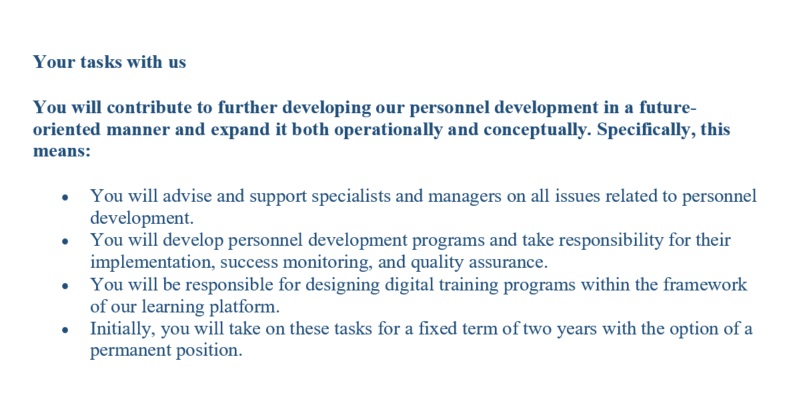Role-based work in non-self-organised teams
Working in roles is very regularly associated with self-organised teams and the holacracy approach [1]. The question I keep asking myself is: why is the importance of role-based working so rarely discussed in non-self-organised teams?
Let me start with a short story: My business partner Teresa and I have blocked off every Monday morning for our joint business. During this time, we work on our product, on the development of our services, on everything that needs to be done. If we both have the time, we also have lunch together after the work block. There was one of these days when we decided to cook together. No sooner said than done! We were at my house, went into the kitchen, inspected the fridge and decided on a salad, vegetables and fried tofu.
Teresa’s first question came immediately: ‘Rebecca, what should I make?’
My answer: ‘You can chop the radishes.’
Immediately followed by the second question: ‘How should I cut the radishes, how would you like them?’
I was irritated by the question: ‘As you like, you’re the radish queen.’
And we’re right in the middle of the topic. We can observe this exact situation every day in the work context. Of course, employees know what position they hold, for example HR development officer, but that doesn’t mean they know what responsibilities and decision-making frameworks go hand in hand with this position. This is not due to the employees, but to the lack of clarity in traditional qualification profiles. And it is precisely at this point that these classic qualification profiles also fail and roles come into focus.
What does role-based working mean?
Let’s go back to the example in the kitchen. If Teresa and I had worked together on a role-based basis, we would have walked into the kitchen, agreed what to eat, both of us would have known what we were responsible for and neither of us would have had to ask questions. Each person would have known directly what to do and what they could decide. This may not make such a big difference with two people, but imagine you are a team of ten people and all nine of them ask you as a manager: What should I do? And how should I do it? This means you lose a lot of your valuable time – and not just you, but also your entire team.
Role-based working means that clear roles are defined for all recurring tasks that exist in the team at time X, which
- the purpose of the role
- the areas of responsibility and
- the decision-making framework within which the role is authorised to make decisions independently.
A role can always be performed by several people, especially if it involves very important responsibilities for the team, and one person always has several roles.
Roles are formulated in much more detail than traditional job profiles.
Here is an example:
Here you can see a very classic job description for a personnel development officer, which I copied from Stepstone:
Suppose the new team you join works with clear role descriptions – what would be different? I’ll take out the point ‘You are responsible for designing digital training programmes as part of our learning platform’ and show you an abbreviated example of what a role description could look like:
Role: ‘Digital training fairy’
Purpose: The digital training programme is always up to date and tailored to the needs of employees.
Responsibility:
- Regularly determines the training needs of employees
- Selects suitable digital learning programmes
- Researches, checks and selects suitable providers
- …
What decides the role:
- Which digital learning content is made available (up to X amount if necessary)
- Which providers to work with
- …
With this role description, it would be possible to clearly start the activity immediately.
And now tell me, why should this only be used in self-organised teams?
What are the challenges and benefits of role-based collaboration?
Teams often face the following challenges when working together:
Confusion: In teams, it is not always clearly defined who has what responsibility and who is authorised to decide what.
Loss of efficiency: Lack of clarity results in frequent enquiries, which leads to interruptions and loss of time for everyone involved.
Loss of quality: Tasks are not always allocated according to strengths and competences.
Demotivation: Also arises due to a lack of focus on strengths and interests when allocating tasks.
Conflicts: Unclear responsibilities and unexpressed different expectations in teams lead to conflicts.
Bottleneck manager: Constant interruptions and a lack of distribution of responsibility lead to major time delays.
If roles are clearly defined and the strengths and competences for the role are defined in addition to the purpose of the role, the areas of responsibility and the decision-making framework, these challenges can be resolved.
Clarity of responsibility: By defining areas of responsibility for each role, every team member knows what they have to do.
Clarity about decision-making frameworks: By defining clear decision frameworks, each team member knows up to where they are allowed to make decisions, and if not, who instead.
Increased efficiency: Clarity regarding responsibility and decision-making frameworks reduces agreements and interruptions.
Better quality: Strength- and competence-based allocation of roles as well as continuous training and further education on the topic.
Greater motivation: The strength- and competence-based distribution of roles means that everyone does what they are good at and enjoy doing. Therefore, there is also greater intrinsic motivation to further develop oneself in the topic.
And how does role-based collaboration work in practice?
Role-based collaboration generally promotes a clear and structured way of working, as tasks, responsibilities and decisions are distributed on the basis of precisely defined roles. However, in order for these advantages to be utilised, there needs to be a high degree of clarity with regard to role descriptions. If roles are not clearly defined and responsibilities are not clearly defined, misunderstandings and conflicts can arise. In this case, we speak of role conflicts, and efficiency suffers as a result.
The roles should be regularly scrutinised, added to or, if necessary, deleted, for example every three months. Possible questions:
- What ambiguities have arisen in the last few weeks?
- What decisions should you be able to make in your role but are not yet allowed to in order to fulfil it well?
- What interfaces and dependencies are there with other roles? How does the collaboration work?
- Between which roles are there conflicts? What do you need to resolve them?
- Which additional roles do you need and which do you no longer need?
There should be transparency about the roles. In concrete terms, this means that the roles should be stored in a central location where they are accessible to everyone.
And roles that affect the entire team, such as the role of moderating meetings, can be rotated.
In role-based collaboration, it is also important that the entire team takes responsibility for achieving the team’s goals. A rigid execution of one’s own role without having an eye for tasks that come into the team and have not yet been defined in any role does not work. In concrete terms, this means that you need a certain degree of flexibility and the ability to look beyond your own role. This could also be a team role that rotates within the team, for example.
Another challenge could be that everyone only thinks in their own role and if good ideas for another role arise, these are not shared. The clear demarcation of roles is important, but the team concept and the achievement of common goals still come first. The motto of ‘ego freedom’ is also essential in role-based working.
Last but not least, it should not be forgotten that it can be challenging at the beginning to suddenly make decisions alone and no longer consult on everything. After all, this is a behaviour that has been learned in many organisations and teams over the years. It is normal to ‘familiarise yourself’ with this new way of working at the beginning.
Notes:
Are you interested in teamwork and developing a culture of trust and a sense of togetherness? Do you want to clarify roles, responsibilities and expectations with external help? Then it’s worth taking a look at Rebecca Hartmann’s fantastic website. Feel free to get in touch if you are interested in team workshops, individual coaching, training or keynote speeches.
[1] Holacracy: A form of structuring organisations with the aim of reducing hierarchies.
If you like the article or would like to discuss it, please feel free to share it with your network.
Rebecca Hartmann has published two more articles in the t2informatik Blog:

Rebecca Hartmann
Rebecca Hartmann is a business psychologist, systemic team developer and coach. She believes that good cooperation does not just happen, but is consciously shaped. She supports managers and teams in enabling truly effective cooperation: with psychological security as a foundation, clear roles as a structure and formats that really work in everyday life. In doing so, she draws on her many years of organisational experience and combines her psychological knowledge with her systemic expertise.
In the t2informatik Blog, we publish articles for people in organisations. For these people, we develop and modernise software. Pragmatic. ✔️ Personal. ✔️ Professional. ✔️ Click here to find out more.


